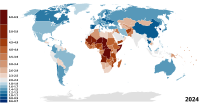
Time intervals between the age at menarche and the onset of sexual activity in Polish women born between 1959 and 2001
Sign Up to like & getrecommendations! Published in 2020 at "American Journal of Human Biology"
DOI: 10.1002/ajhb.23436
Abstract: The aim of this study was to assess time intervals between the age at menarche (AM) and age at sexual initiation (ASI) in Polish women born before and after the political transformation period in Poland. read more here.
Keywords: polish women; age; time intervals; intervals age ... See more keywords

Son Preference of Immigrants to the United States: Data from U.S. Birth Certificates, 2004–2013
Sign Up to like & getrecommendations! Published in 2017 at "Journal of Immigrant and Minority Health"
DOI: 10.1007/s10903-017-0589-1
Abstract: Son preference has existed for centuries in many cultures and societies. In some Asian countries, including China and India, the sex ratio at birth (SRB, number of male infants divided by number of female infants… read more here.
Keywords: 2004 2013; birth; birth certificates; women born ... See more keywords

Changing trends between education, childlessness and completed fertility: a cohort analysis of Australian women born in 1952–1971
Sign Up to like & getrecommendations! Published in 2021 at "Journal of Population Research"
DOI: 10.1007/s12546-021-09269-x
Abstract: Little is known about whether and how trends in completed cohort fertility and lifetime childlessness by education have changed over time. This study uses census data to describe the changes in completed family size and… read more here.
Keywords: born 1952; australian women; women born; childlessness ... See more keywords

Cliff-edge model predicts intergenerational predisposition to dystocia and Caesarean delivery
Sign Up to like & getrecommendations! Published in 2017 at "Proceedings of the National Academy of Sciences of the United States of America"
DOI: 10.1073/pnas.1712203114
Abstract: Significance The cliff-edge model explains the evolutionary persistence of relatively high incidences of fetopelvic disproportion (FPD), the mismatch of fetal and maternal dimensions during human childbirth. It also predicts that FPD rates have increased evolutionarily… read more here.
Keywords: cliff edge; model; edge model; women born ... See more keywords

Association Between Preterm Birth and Lower Adult Height in Women
Sign Up to like & getrecommendations! Published in 2017 at "American Journal of Epidemiology"
DOI: 10.1093/aje/kww116
Abstract: We examined whether being born preterm was associated with changes in adult anthropometry in women. We assessed data on 201,382 women (born in 1973–1988) from the Swedish Birth Register. The mean age was 26.0 years.… read more here.
Keywords: women born; born preterm; born term; born moderately ... See more keywords

Does women’s place of birth affect their opportunity for an informed choice about Down syndrome screening? A population-based study in France
Sign Up to like & getrecommendations! Published in 2021 at "BMC Pregnancy and Childbirth"
DOI: 10.1186/s12884-021-04041-8
Abstract: To examine disparities by maternal place of birth in the opportunity to make an informed choice about Down syndrome screening, in France, where the national guidelines recommend that physicians offer it to all pregnant women.… read more here.
Keywords: informed choice; opportunity; women born; syndrome ... See more keywords

Changes in individual and contextual socio-economic level influence on reproductive behavior in Spanish women in the MCC-Spain study
Sign Up to like & getrecommendations! Published in 2020 at "BMC Women's Health"
DOI: 10.1186/s12905-020-00936-4
Abstract: Background The association between socioeconomic level and reproductive factors has been widely studied. For example, it is well known that women with lower socioeconomic status (SES) tend to have more children, the age at first-born… read more here.
Keywords: spanish women; women born; individual contextual; level ... See more keywords